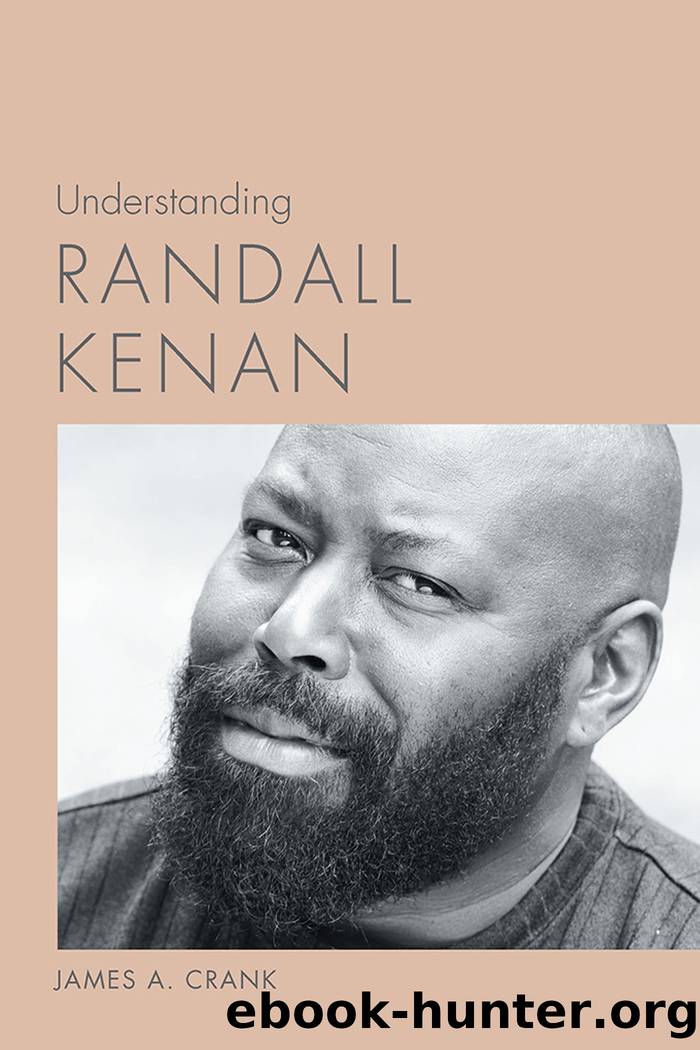Understanding Randall Kenan by James A. Crank

Author:James A. Crank
Language: eng
Format: epub
Publisher: University of South Carolina Press
Published: 2019-08-15T00:00:00+00:00
CHAPTER 4
Brother Baldwin and the Shadow of Tims Creek
âWhat I hate about writing non-fiction is that I canât tell the truth. Well, of course, you can tell the truth, but you have to find another way to tell it. I mean, if somebody is sitting there and she reminds you of a bullfrog, in fiction you can say: She put him in mind of a bullfrog. But if you know the woman, the woman is living, and you know the woman is going to read it, you canât say that. Thatâs one of the problems with non-fiction for me. I canât be honest on the same level.â
Kenan in conversation with V. Hunt
Randall Kenanâs tremendous success as a fiction writer sometimes obscures his accomplishments in other genresâmost notably nonfiction, book reviews, criticism, journalism, and personal essays. This chapter chronologically works through Kenanâs nonfiction writings and pays special attention to his book-length works. Although the writer has yet to publish a novel or fiction collection since the publication of Let the Dead Bury Their Dead in 1992, he has continued to work on a novel that he hopes to publish within the next few years, tentatively titled Thereâs a Man Going âRound Picking Names.
âSorrowâs Childâ (1992)
Kenanâs review of Dorothy Allisonâs debut novel Bastard Out of Carolinaâreleased the same year as Kenanâs own Let the Dead Bury Their Deadâis unique in that the young author seems to be talking to himself about the subject of much of his fictionâthe emotional and economic landscape of poor southerners.1 Calling Allisonâs novel both âworrisome and braveâ (815), Kenan further explains: âBrave because in so many ways this far more bitter than sweet Bildungsromanâs real subject is not âTrashâ (the name of Allisonâs prize-winning collection of stories) but the explosive and often difficult to understand world of child abuse; it is also a Faulknerianly bold attempt to plumb the depths of one girlâs emotional acceptance, initially, of such cruelty. Yet so closely linked to this story is a particular environment that engenders this particular tragedy that when this environment fails to convince thoroughly, Allisonâs overarching theme comes dangerously close to running aground. Luckily, she pilots her ship if not always masterfully, often with fine skillâ (815).
Kenan is especially anxious over Allisonâs portrayal of poverty and white trash, which he notes can be tricky to explore without falling into images of âliquored-up, malevolent, unemployed, undereducated, country-music-listening, oversexed, foul-tempered men; and long-suffering, quickly aging, overly fertile, too-young-marrying, hardheaded womenâ (815). Kenan is especially interested in âthe way death functions in the novelâvery like the way it functions in Southern lifeâ (816), and a careful reader might find in his obsession with southern death a connection to the authorâs own exploration of the subject in his fiction. Kenanâs conclusion is that Allison has made something true out of her own obsessionsâwith stereotypes of poverty and trash: âpecan pie and gospel music, snuff-dipping grannies and kissing cousins notwithstandingâBastard Out of Carolina is a singular and important act of art and courageâ (816).
Download
This site does not store any files on its server. We only index and link to content provided by other sites. Please contact the content providers to delete copyright contents if any and email us, we'll remove relevant links or contents immediately.
4 3 2 1: A Novel by Paul Auster(11788)
The handmaid's tale by Margaret Atwood(7446)
Giovanni's Room by James Baldwin(6807)
Asking the Right Questions: A Guide to Critical Thinking by M. Neil Browne & Stuart M. Keeley(5355)
Big Magic: Creative Living Beyond Fear by Elizabeth Gilbert(5350)
Ego Is the Enemy by Ryan Holiday(4954)
On Writing A Memoir of the Craft by Stephen King(4660)
The Body: A Guide for Occupants by Bill Bryson(4580)
Ken Follett - World without end by Ken Follett(4441)
Bluets by Maggie Nelson(4259)
Adulting by Kelly Williams Brown(4231)
Eat That Frog! by Brian Tracy(4147)
Guilty Pleasures by Laurell K Hamilton(4115)
White Noise - A Novel by Don DeLillo(3828)
The Poetry of Pablo Neruda by Pablo Neruda(3813)
Fingerprints of the Gods by Graham Hancock(3731)
Alive: The Story of the Andes Survivors by Piers Paul Read(3728)
The Book of Joy by Dalai Lama(3694)
The Bookshop by Penelope Fitzgerald(3615)
